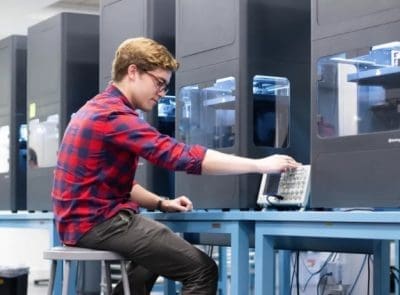RED meat processors are working to establish a world-first, industry-owned 3D printing service model to help operators to print replacement equipment parts, revolutionising equipment maintenance and helping underpin continuous supply of meat products.
Additive manufacturing, also known as 3D printing, has been around for about a decade, however new uses for the technology are constantly being discovered.
 The Australian Meat Processor Corporation is working with 3D printing technology companies Markforged and Konica Minolta to investigate its potential in meat processing operations.
The Australian Meat Processor Corporation is working with 3D printing technology companies Markforged and Konica Minolta to investigate its potential in meat processing operations.
In a high-volume environment like a processing plant, parts like bolts and rollers can wear or break. As in any industry, time is money, and if a part fails the result can be lost productivity and expensive down-time until a replacement is sourced, delivered and fitted. With 3D printing, the industry can benefit from parts replacement, creation, and refinement.
AMPC chief executive Chris Taylor said meat processors relied on a multitude of equipment, with multiple components. Even a small component failure could be a costly exercise, he said.
“The ability to simply print a replacement part could drastically reduce downtime and minimise the need to wait for parts, reducing the chance of supply being at risk,” he said.
Konica Minolta’s innovation product marketing manager Matthew Hunter said the need for sovereign capability for the Australian supply chain coupled with Australian government support for local food and beverage manufacturing, had resulted organisations looking to adopt innovative practices.
Richard Elving, Director of Sales Asia-Pacific, Markforged, said supply chain issues could be costly and time-sensitive, and with 3D printing tools in place, AMPC would help provide a competitive advantage to its members that enables processing facilities to react quickly to solve problems right on the manufacturing floor.
The collaboration involves a three-year, multi-faceted program so that these benefits can be realised at meat processing plants across Australia. The program’s first stage will see two Markforged mobile carbon fibre industrial 3D printers shipped to Australian processing plants.
Processing staff will be trained to use them so they can assess whether buying a permanent unit would be a good investment. The units will remain on site for four to eight weeks before rotating to another plant.
The printers can create pre-metal prototypes for assessment as well as producing non-metal parts. Konica Minolta will provide on-site support to help meat processors understand and leverage the technology.
A second part of the program will see a metal printing 3D industrial unit (metal X system) set up at Konica Minolta’s Sydney location, dedicated for parts manufacturing use by red meat processors.
Plastic prototypes made at each processing location will be sent to this hub to be made out of stainless steel and other metals in as little as 24 hours. A red meat 3D parts database library will ensure all parts are quality controlled.
“When it comes to meat processing, there are a number of challenges for equipment maintenance,” Mr Hunter said. “This includes the use of old equipment with limited spare parts availability and the need to produce custom parts. 3D printing helps address these challenges. Through the database, AMPC’s member organisations will have access to intellectual property to expediate and streamline their repairs processes,” he said.
With the ability to rapid prototype with 3D printing and produce one-off 3D parts, Australian meat processors will also be able to modify equipment and/or equipment components to suit their own specific needs by making changes to tooling, fixtures, brackets, and actuators.
Currently many of these modifications, customisations, and consolidations simply cannot be done.
AMPC’s Chris Taylor said the processing sector was part of an ‘ecosystem’ that performs best when all parts are optimised.
“Although established and dedicated for Australian red meat processors, AMPC will make the 3D printing hub available for other Australian food, agriculture, and manufacturing sectors to evaluate their needs and opportunities for 3D printing within their supply chains,” he said.
Source: AMPC
